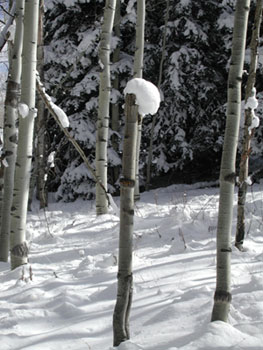
By Long Walker
Pacific Northwest Field Editor

"Yeah, that dump last night gave us another eight inches or so since I was back up in here a couple days ago," was my reply. "Right after you and I split up, I figured it was getting a little deep for the deer up on the ridges. I just walked through 15 fresh beds in that little stringer of timber in the bottom, all within 30 yards of the creek bed. There is at least one huge ruttin buck track in there along with his bed. And stink! He smells ranker than a bull elk," I continued. " I found a big cedar that went down because of the heavy snow during the night and they were really working it over for the lichens. Most everything else is buried. You know, we did this wrong. If I had realized that the deer were forced down so low last night, I woulda put you on that escape route into the big brush field instead of watching the north slope."
And so it goes. The best-laid plans of hunters everywhere are laid low by the weather. Too hot, too cold, not cold enough. Ask for just a little tracking snow, and you step out the door into knee-deep powder.
Chad and I were carrying out an old tradition of ours. A Thanksgiving morning whitetail hunt. Truly a magic time in our home range, the peak of the rut.
"You got time to have me push the brush field? I’ll show you where to sit," I asked.
"Its quarter to 12 so I’ve only got 20 minutes and this year it’s the in-laws for supper," was his chagrined reply. "Don’t EVEN want to be late for that one."
"I don’t know about that, but I do know that most of the deer I have been seeing here this summer have pulled out for the winter range. These are new deer in here that have already been pushed out of the high country. This is starting to stack up just like the winter of 96/97"
For the first time in seven or eight years, North Idaho hunters had been blessed with a great mantle of the white stuff that came and stuck for our regular November deer season.
Last year not a flake fell and conditions remained tough to the bitter end. But this was too much. Here it was just November with at least three months of winter in front of them and the deer, and to a lesser extent elk, were already piling into the winter ranges. It was cause for concern.
Back in 1996, the snow came and stayed beginning in October and did not relent for months. I was forced to plow myself out every day for 60 days straight.
Finally in January of 1997, it did quit snowing but remained cold. Our local ski areas that ordinarily enjoy an 8- to 9-foot snowpack received 23 feet. All across our northern mountains, wherever the deer and elk were calling home when the snow began coming down that fall, is where we found their bones when we could get into the backcountry the following late July. The toll was terrible and affected our hunting for years.
One all-important weather factor that was missing back in '96 really compounded the devastation of our herds. We did not get our "January thaw."
Unbeknownst to many hunters who do not reside in snow country is this phenomenon of a midwinter thaw. While our nonresident friends in the southerly latitudes perceive us northerners as being locked in an icy unrelenting grip of subzero cold, ice and snow, such is not always the case.
Even the most severe winter usually includes at least one period of moderated temperature and precipitation. In our area, a warm southwesterly flow bringing warming temperatures up from the Pacific Ocean that eventually scours out the entrenched arctic air mass usually brings this about. This is also sometimes referred to as a "Chinook," the "warm winds." And if accompanied by rain, so much the better. Warm rains can take a snowpack down to nothing in short order. Normally, this much-needed respite for our game animals occurs in mid-January.
I can recall jump-shooting a pair of big, fat northern greenhead mallards on the unfrozen pond behind my house on a 51-degree January 18th day. This is in the extreme, of course.
I have also seen the thermometer on the bank downtown registering minus 38. Brrrrr is right!
This year 58 inches of our area’s normal 67 inches fell before January 15th, forcing game to move much earlier than normal. Big game managers were becoming concerned.
Luckily, this year we did get our January thaw with temperatures climbing into the 40s and remaining above freezing both night and day for nearly two weeks. The snowpack has been reduced enough to alleviate any yarding of deer and allow them to scatter a bit and disperse into differing elevations. This reduces the stress associated with overcrowding.
Big game forced to live in such conditions, packed atop one another, are much more susceptible to the spread of disease and fall easy prey to cougars, poachers and vehicles.
Also, overbrowsing may occur and the vegetation on the winter range can be damaged to the point that it does not grow back as it should. The following winter the game returns, only to find that the depleted browse cannot provide the necessary nutrition in subsequent winters.
Our extended forecast from those who know, calls for warmer than normal temperatures for the remainder of our winter. For the sake of your next fall’s hunting season, let us hope so!
And now that we got you thinking about next season, think about how you are going to TAKE A KID HUNTING!
Copyright © 2004 J & D Outdoor Communications. All rights reserved.